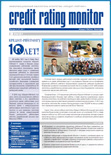Methodology
The assignment procedure of a credit rating is based upon the following fundamentals: quality and fairness of the rating process; independency of the rating agency and prevention of conflicts of interest; the agency’s responsibility towards investors and issuers.
The rating agency employs methodology and approaches in risk assessments, which meet the standards of the world’s leading rating agencies.
The Credit-Rating’s experts use special ways of creditworthiness assessments for different types of companies and their debt instruments:
- methodology for assessment of companies (with consideration of nature of industries) (rus)
- methodology for assessment of insurance companies (rus)
- methodology for assessment of banks (rus)
- methodology for assessment of regions (municipality) (rus)
- methodology for assessment of bank deposit ratings (rus)
- methodology for assessment of insurer Strength Rating (rus)
- methodology for assessment of information security rating (rus)
- Description of CIS ratings methodology
While assessing an entity we consider the following key issues:
- analysis and development perspectives of the sector in which an entity operates;
- the entity’s reputation and track record;
- availability of a market niche for the entity, competitive strength of entity’s products, diversification of activities;
- correspondence of the entity’s activities with legislation affecting activities in the sector;
- entity’s participation in groups of associated companies, role of the entity in the group, principles of interaction and distribution of cash flows within the group;
- level of the entity’s autonomy (availability of sufficient production facilities, skilled employees, raw materials base, storage and sale system, diversification by counterparties);
- entity’s management quality;
- entity’s indicators of financial and economic performance and their dynamics (size of equity and assets, capital structure, entity’s profitability and solvency, sufficiency of cash flows for payments on obligations);
- plans and development outlooks.
We additionally consider the following factors when assessing a construction company:
- availability of documents necessary for construction works (licenses, allocation of land, permits for construction works, etc.);
- experience in construction and in commissioning newly built objects (of a company or its associated companies, of company’s managers or owners, of general contactor or customer);
- framework of relations with the customer, general contactor and investors;
- keeping up with the schedule of construction works;
- extent of the company’s participation in the project with own funds;
- size of the planned construction works;
- the project’s region and level of demand in this region.
Key factors considered while assessing insurance companies:
- range of the company’s products and its market share;
- the company’s primary business, principal categories of its customers, promotion channels;
- availability of a wide-spread network of outlets;
- expertise of company’s employees, extent of thoroughness of insurance agreements;
- company’s business reputation;
- participation in financial and industrial groups;
- competitive strength of tariff policy;
- amount, diversification and reliability of financial investments;
- balances in the insurance portfolio;
- level of management of insurance risks;
- company’s indicators of financial and economic performance and their dynamics (size and structure of company’s equity and assets, portion of insurance reimbursements, share of reinsurance in the overall volume of services, amount of provisions, company’s profitability and solvency, sufficiency of cash flows for payments on obligations);
Key factors considered while assessing banks:
- extent of bank’s universality and its core business;
- number of customers and structure of clientele;
- bank’s level of capitalization;
- bank’s participation in financial and industrial groups;
- share of transactions with insiders and associated parties;
- dependency upon certain customers, transactions and markets;
- bank’s competitive strength in terms of quality of its services and price policy;
- efficiency of bank’s structure and procedures for decision making;
- availability of a wide-spread network of outlets;
- level of development of information technologies;
- level of risk management, presence of risk management divisions and their structure;
- bank’s key figures and their dynamics (diversification of attracted and placed funds, balance between terms of attraction and placement, quality of loan portfolio, level of provisions, performance efficiency);
- meeting the NBU’s standards;
- amount of profit, returns on assets and equity, income structure;
- potential for growth and entering new markets;
- presence of development strategy.
While determining a credit rating of a region (municipality) we conduct independent assessment of aspects of its activities as an entity of local self government and efficiency of these activities, including the following:
- level of social and economic development (we assess the indicators, which reflect capacity of the region (municipality) to form a resource base for meeting its obligations: demographic situation and labor resources, manufacturing and non-manufacturing sectors, investment activities and foreign economic activity);
- financial state (incomes to the local budget and expenses for implementation of programs and events initiated by the local council, analysis of their structures, dynamics and balance framework; factors which may prompt misbalance between incomes and expenditures of the municipality);
- debt obligations, including their amounts, dynamics and structure, as well as debt burden on the local budget in terms of servicing the obligations and their repayment;
- available communal property and quality of its accounting and management systems;
- existing management system, political situation in the region and level of consolidation between different branches of authority;
-
plans and development outlooks.





